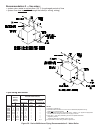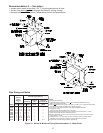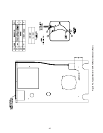
41
M. CONNECT TANKLESS HEATER PIPING as
shown in Figure 38. See Table IV for Tankless Heater
Ratings.
1. Install Flow Regulator
If flow through the heater is greater than its rating,
the supply of adequate hot water may not be able to
keep up with the demand. For this reason a FLOW
REGULATOR matching the heater rating should be
installed in the cold water line to the heater. Refer
to Figure 36 for piping recommendations. Locate
the flow regulator below the inlet (cold water side)
of the heater and a minimum of 36” away from the
inlet so that the regulator is not subjected to excess
temperatures during “off” periods when it is possible
for heat to be conducted back through the supply
line. The flow regulator will limit the flow of supply
water regardless of inlet pressure variations ranging
from 20 to 125 psi.
2. Install Water Temperature Mixing Valve
Refer to Figure 38 for piping recommendations.
Adjust and maintain the mixing valve in accordance
with manufacturer’s instructions.
Installation of a mixing valve will also lengthen the
delivery of the available hot water by mixing some
cold water with the hot. In addition, savings of hot
water will be achieved since the user will not waste
as much hot water while seeking desired water
temperature. Higher temperature hot water required
by dishwashers and automatic washers is possible
by piping the hot water from the heater prior to
entering the mixing valve. An electric hot water
booster can also be used.
The mixing valve should
be “trapped” by installing it below the cold water
inlet to heater to prevent lime formation in the valve.
3. Flushing of Heater
All water contains some sediment which settles
on the inside of the coil. Consequently, the heater
should be periodically backwashed. This is
accomplished by installing hose bibs as illustrated
in Figure 38 and allowing water at city pressure to
run into hose bib A, through the heater, and out hose
bib B until the discharge is clear. The tees in which
the hose bibs are located should be the same size as
heater connections to minimize pressure drop.
4. Hard Water
A water analysis is necessary to determine the
hardness of your potable water. This is applicable
to some city water and particularly to well water.
An appropriate water softener should be installed
based on the analysis and dealer’s recommendation.
This is not only beneficial to the tankless heater but
to piping and fixtures plus the many other benefits
derived from soft water.
NOTICE
The following guidelines should be followed
when piping the tankless heater:
WARNING
Install a mixing valve at the tankless heater
outlet to avoid risk of burns or scalding
due to excessively hot water at fixtures.
Do not operate the boiler when equipped
with a tankless heater unless mixing valve
is operating properly.
CAUTION
Do not operate tankless heater with hard
water. Tankless failure will result. Install
water softener if hard water is present.
Figure 36:
Mounting Elevations
of M&M 150, 64 and 67
Float Low Water Cut-offs.
"A" "B"
67 35-1/2" -
64 - 37-1/2"
150 - 40"
Primary or Secondary
Primary (Gravity Return)
Primary (Pumped Return)
Cut-Off Height
ApplicationL.W.C.O.
“A”
“B”


















